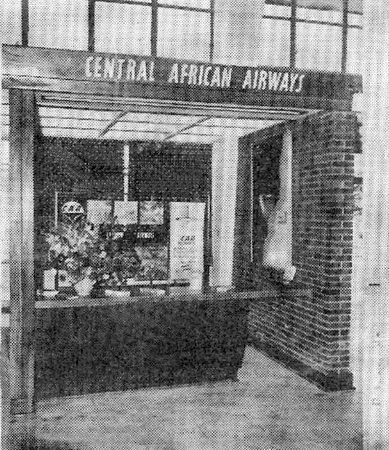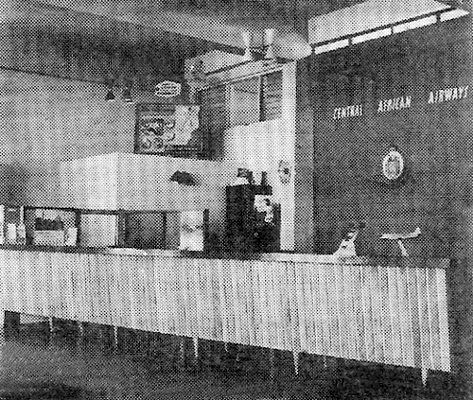The Opening of Bulawayo Airport
The first C.A.A., Viscount RMA "MWERU" to land at Bulawayo Airport.
Here shown in front of the new buildings.
Here shown in front of the new buildings.
On the 5th January, 1959, we, Central African Airways, the National Airline of the Federation of Rhodesia and Nyasaland, moved our services from the old Kumalo Airport, Bulawayo, to the new Bulawayo Airport and introduced to Bulawayo for the first time, Viscount schedules which are now operated regularly between Salisbury and Bulawayo. Six services a week in each direction are also operated by C.A.A. and S.A.A. (South African Airways) Viscounts between Bulawayo and Johannesburg.
The new airport, built at a cost of £960,000. conforms to classification D. 3 of the International Civil Aviation Organisation, but is capable of extension to classification C. 3.
The two-floored terminal building contains restaurant, lounge and bar facilities, and wave base on the first floor and concourse, weigh bays, customs, immigration and health, airline and operating offices and freight store on the ground floor. The concourse and public spaces of the terminal are being heated by a system of under floor electric elements, believed to be the first such station in the Federation and one with the advantages of low capital and running costs. Contiguous with the terminal building at first floor level is the control building, housing an air-conditioned, sound-proof control room, telecommunications, meteorological offices, briefing rooms, equipment and control rooms and the Airport Manager's office. Both buildings are of contemporary design.
Nearly 20 miles of cable have been buried on the site to feed the duplicate runway and taxi lights, flashing beacon and red lead-in lights and stand-by diesel generating plant is installed to take over automatically in case of any interruption in the power from the Electricity Supply Commission.
There is also a modern sewage disposal works to handle a total flow of 34,000 gallons of sewage per day with a possible extension to twice this capacity, while 5,000,000 gal1on storage tanks deal with the water supply from the Bulawayo Municipality. Approximately six miles of piping completes the reticulation within the airport boundaries.
There is also a modern sewage disposal works to handle a total flow of 34,000 gallons of sewage per day with a possible extension to twice this capacity, while 5,000,000 gal1on storage tanks deal with the water supply from the Bulawayo Municipality. Approximately six miles of piping completes the reticulation within the airport boundaries.
The main runway, present length 6,600ft. by 150ft. wide, and ultimate length obtainable 10,800ft., is designed to take an equivalent single isolated wheel load of 60,000 lbs. at a tyre pressure of 100 lbs. It has a concrete strip at the western end to offset blast and heat from jet aircraft and the apron too is concrete. There are two hydrant fuelling bays on the apron.
Fire services, transferred from Kumalo consist of two major fire tenders, one water tanker, one minor foam tender, one rescue saw tender and one ambulance.
Telecommunications service and aids to navigation include the main aerodrome non-directional radio beacon, an inner, an outer locator non-directional radio beacon, a holding non-directional radio beacon at Essexvale, v.h.f. automatic direction finding equipment, the distance measuring equipment, and the normal air-to-ground and point-to-point radio and teleprinter facilities provided at major Federal aerodromes and storm detection radar equipment operated by a Meteorological Department.
The completion date for major civil engineering works is March 31st, 1959.
A 'MOVING" DAYfor C. A. A. Bulawayo.
It was not without a feeling of nostalgia that we left Kumalo, watching the old, squat buildings fade into the distance as our assorted convoy, headed by a vintage Ford Anglia, trundled onto the highway. Behind us followed two five-ton trucks loaded with the impahle (belongings) of our African staff who were clinging to their belongings with grim determination.
Bulawayo Airport (not Woodvale, please) is situated some fourteen miles from the city. At night, when the coloured runway lights shine against a gleaming rainbow backdrop of Bulawayo's myriad visitors are afforded a splendid impression of the city.
The airport buildings are not only attractive but promise, when completed, to offer first-class traffic handling facilities, and have the added advantage of providing staff offices with windows overlooking the tarmac.
The airport buildings are not only attractive but promise, when completed, to offer first-class traffic handling facilities, and have the added advantage of providing staff offices with windows overlooking the tarmac.
At 21.00 hours on January 4th 1959 Flight CE 843 from Salisbury landed in a rainstorm. It was the first Viscount on a scheduled flight to touch down at the new airport
The next day one of its passengers volunteered this comment: 'I was very impressed at your superintendent standing soaking in the rain helping passengers into the coaches. I also found your staff most helpful.' Such words of praise to start the first day were most encouraging.
Monday the 5th January saw the first Viscount CE 840 to Salisbury with Captain Nash piloting and 29 passengers on board.
The next day one of its passengers volunteered this comment: 'I was very impressed at your superintendent standing soaking in the rain helping passengers into the coaches. I also found your staff most helpful.' Such words of praise to start the first day were most encouraging.
Monday the 5th January saw the first Viscount CE 840 to Salisbury with Captain Nash piloting and 29 passengers on board.
Later that morning Flight CE 841 from Salisbury - VP-YNB with Captain Orbell at the controls landed on the wet tarmac to deposit the Mayor and Mayoress of Bulawayo (who had flown to the capital overnight especially to make this inaugural flight) the Mayor and Mayoress of Salisbury and other officials, who were greeted by a battery of Press cameras and besieged by reporters for whom this was to be Tuesday's front-page news.
Having seen the last of the V.I.P. s off on the drive into Bulawayo we turned from the hustle and bustle of Press interviews to the humdrum affairs of moving house. Standing forbiddingly aloof outside the cargo office was our 2-ton Chubb safe, where it had been dumped off a truck and left for us to move inside the building. One look at this huge chunk of metal and faces drooped. An exhaustive search for African helpers provided us with the African staff of the Aeradio, Met. and caretaker's section, along with our own Africans.
The speed used on this job was set - Dead Slow. No other was possible. Panting, straining, sweating ... coloured by a painful grunt from one unfortunate African who forgot to remove his finger in time as the mighty safe was heaved onto rollers; the movement of this one important piece of office equipment caused us more labour than the rest of the moving. But it had to be done. So far only one member of staff has been misguided so as to suggest to the Station Supt. that the safe has been wrongly positioned in the Cargo Office!
Thus ended our memorable first day at Bulawayo Airport.
Having seen the last of the V.I.P. s off on the drive into Bulawayo we turned from the hustle and bustle of Press interviews to the humdrum affairs of moving house. Standing forbiddingly aloof outside the cargo office was our 2-ton Chubb safe, where it had been dumped off a truck and left for us to move inside the building. One look at this huge chunk of metal and faces drooped. An exhaustive search for African helpers provided us with the African staff of the Aeradio, Met. and caretaker's section, along with our own Africans.
The speed used on this job was set - Dead Slow. No other was possible. Panting, straining, sweating ... coloured by a painful grunt from one unfortunate African who forgot to remove his finger in time as the mighty safe was heaved onto rollers; the movement of this one important piece of office equipment caused us more labour than the rest of the moving. But it had to be done. So far only one member of staff has been misguided so as to suggest to the Station Supt. that the safe has been wrongly positioned in the Cargo Office!
Thus ended our memorable first day at Bulawayo Airport.
Interior view of our Sales Office in Tregar House, Abercorn Street.
End
Stop Press
We quote the following from a recent Government Notice ....
'It is hereby notified that His Excellency the Governor General has been pleased, in terms of Section 4 of the Public Health Amendment Act., to designate the Salisbury and the Bulawayo Airports as sanitary airports..'
Nice to know that we are 'clean round the bend'.
End
All articles and photographs were extracted from the SCAANER of April 1959 which was made available by Dave Vermaak.
Comments are always welcome, please mail them to Eddy Norris at orafs11@gmail.com and they will be loaded to this article.
(Please visit our previous posts and archives)
Ref. Rhodesian Aviation
Ref. Rhodesian Aviation





0 Comments:
Post a Comment
Subscribe to Post Comments [Atom]
<< Home